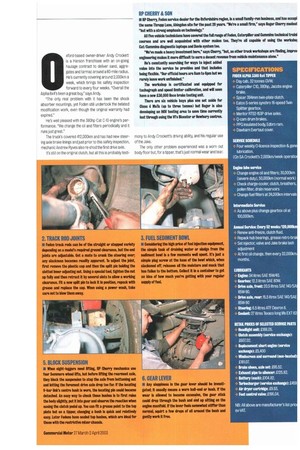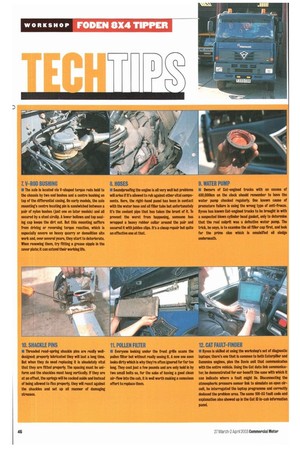FOR LONG SERVICE FODEN ALPHA 3380
Page 44

Page 45

Page 46

If you've noticed an error in this article please click here to report it so we can fix it.
The Foden kite mark still has meaning, especially to owner-operators like Andy Crockett who's well satisfied with the earning power of his four-year old Cat-powered Alpha 3380. But while he appreciates the marques unique image, he also knows that regular care and maintenance are the most vital ingredients. While keeping the cab interior spotless, he's confident that his local Foden service dealer, RP Cherry, will take care of the rest. That's where Orvan Jarvis caught up with technician Andy Ryves (above), who was about to start on its periodic safety check.
1. RUBBER SUSPENSION
• Fedett's FF20 rubber rear bogie wringing is a well tried and tested suspension medium but on sites or heavy-duty work, the bolt sets on the rubber 'elephant's feet' have a tendency to work loose. There are eight bats per bolster and, using the common hammer tap method, check all of them for tightness, Each pack is just a sandwich of rubber pads and metal plates but occasionally the adhesive gives and they begin to separate, so its also important to examine them closely, especially on the inside.
2. TRACK ROD JOINTS
Foden track rods can be of the straight or stepped variety depending on a model's required ground clearance, but the end joints are adjustable. Get a mate to crank the steering over; any slackness becomes readily apparent. To adjust the joint, first remove the plastic cap and then the split pin holding the slotted inner adjusting nut. Using a special tool, tighten the nut up fully and then retract it by several slots to allow a working clearance. Fit a new split pin to lock it in position, repack with grease and replace the cap. When using a power wash, take care not to blow them away.
3. FUEL SEDIMENT BOVA • c•naming the mgh price of fuel injection equipment, the simple task of draining water or sludge from the sediment bowl is a few moments well spent. It's just a simple plug screw at the base of the bowl which, when slackened off, releases all the moisture and muck that has fallen to the bottom. Collect it in a container to get an idea of how much you're getting with your regular supply of fuel.
4. LOAD SENSING
Mud and road grime gets onto the load-sensing valve linkage and will eventually cause it to stick, Usually, it will seize up when the vehicle is fully loaded, and this causes the brakes to grab. But If it jams up while unladen, the braking efficiency falls away. On every Inspection. Ryves operates the linkage by hand and if there's a hint of drag, he'll give the valve stem a quick spray of W040 arid work it free.
5. BLOCK SUSPENSIRk
• When eight-leggers need lifting, RP Cherry mechanics use four Sommers wheel lifts, but before lifting the rearmost axle, they block the suspension to stop the axle from bottoming out and letting the foremost drive axle drop too far If the locating V-bar link's centre bush is worn, the locating pin could become detached. An easy way to check these bushes is to first raise the body slightly, put it into gear and observe the reaction when easing the clutch pedal up. You can fit a grease point to the top plate but on a tipper, chanting a bush Is quick and relatively easy. Later Fodens have sealed top bushes, which are ideal for those with the restrictive mixer chassis.
6. GEAR LEVER
11 Any sloppiness in the gear lever should be Investigated; It usually means a worn ball-end or bush. If the wear is allowed to become excessive, the gear stick could drop through the bush and end up sitting on the engine manifold. If the lever feels somewhat stiffer than normal, squirt a few drops of oil around the bush and gently work it tree.
7. V-ROD BUSHING
• The axle is located via V-shaped torque rods held to the chassis by two end bushes and a centre bushing on top of the differential casing. On early models, the axle mounting's centre locating pin is sandwiched between a pair of nylon bushes (just one on later models) and all secured by a steel circlip. A lower bellows and top sealing cap keeps the dirt out. But this mounting suffers from driving or reversing torque reaction, which is especially severe on heavy quarry or demolition site work and. over several years, they start to deteriorate. When renewing them, try fitting a grease nipple in the cover plate; it can extend their working life.
8. HOSES
m Soundproofing the engine is all very well but problems will arise if it's allowed to rub against other vital components. Hero, the right-hand panel has been in contact with the water hose and oil filler tube but unfortunately its the coolant pipe that has taken the brunt of it. To prevent the worst from happening, someone has wrapped a heavy rubber collar around the pair and secured it with jubilee clips. It's a cheap repair but quite an effective one at that.
9. WATER PUMP
II Owners of Cat-englned trucks with an excess of 4.10.000km on the clock should remember to have the water pump checked regularly. One known cause of premature failure is using the wrong type of anti-freeze. Byres has known Cat-engined trucks to be brought in with a suspected blown cylinder head gasket, only to determine that the real culprit was a defective water pump. The trick, he says, is to examine the oil filler cap first, and look for the prime clue which is emulsified oil sludge underneath.
10. MNS
• Threaded road-spring shackle pins are really welldesigned; properly lubricated they will last a long time. But when they do need replacing it is absolutely vital that they are fitted properly. The spacing must be uniform and the shackles must hang vertically. If they are at an offset, the springs will be cocked aside and instead of being allowed to flex properly, they will react against the shackles and set up all manner of damaging stresses.
11. POLLEN FILTER
In Everyone looking under the front grille scans the pollen filter but without really seeing it. A new one soon looks dirty which is why they're often ignored for far too long. They cost just a few pounds and are only held in by two small bolts so, for the sake of having a good clean air-flaw Into the cab, it is well worth making a conscious effort to replace them.
12. CAT FAULT-FINDER
Ryves is skilled at using the workshop's set of diagnostic laptops; there's one that is common to both Caterpiller and Cummins engines, plus the Davie unit that communicates with the entire vehicle. Using the Cat data link communicator, he demonstrated for our benefit the ease with which it can indicate where a fault might lie. Disconnecting the atmospheric pressure sensor link to simulate an open circuit, he interrogated the laptop programme and correctly deduced the problem area. The same 108-03 fault code and explanation also showed up in the Cat 10 in-cab information panel.












































































































































































